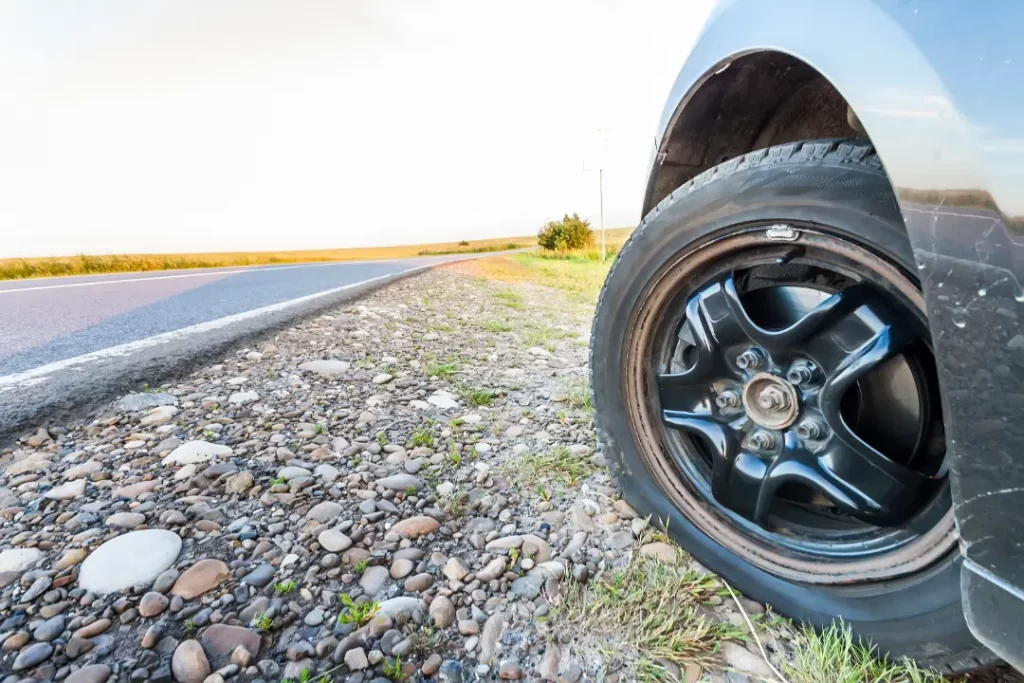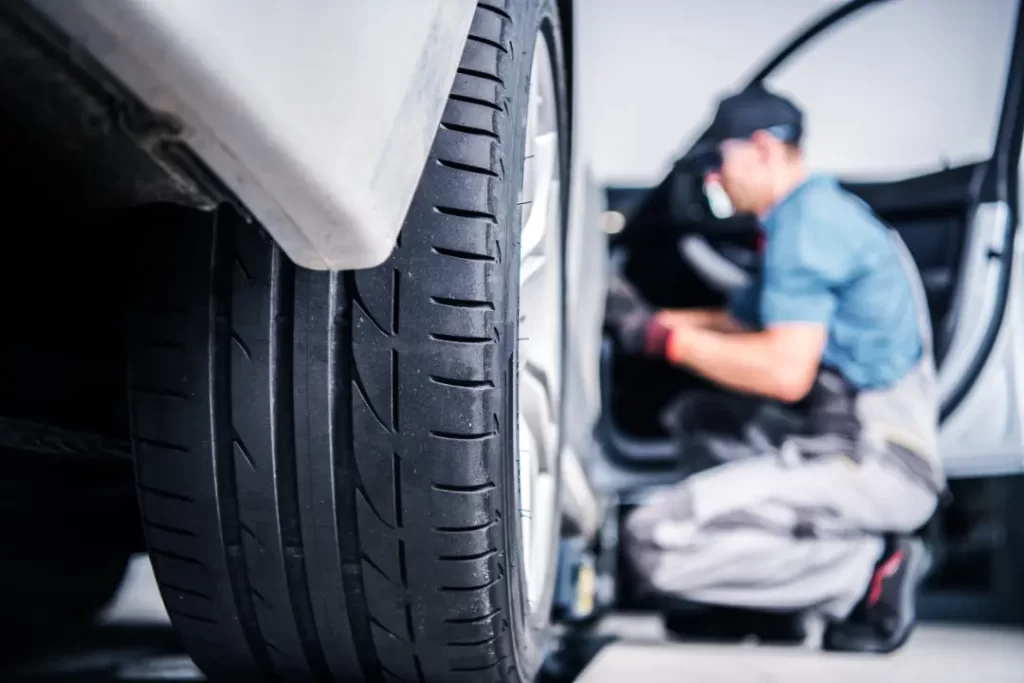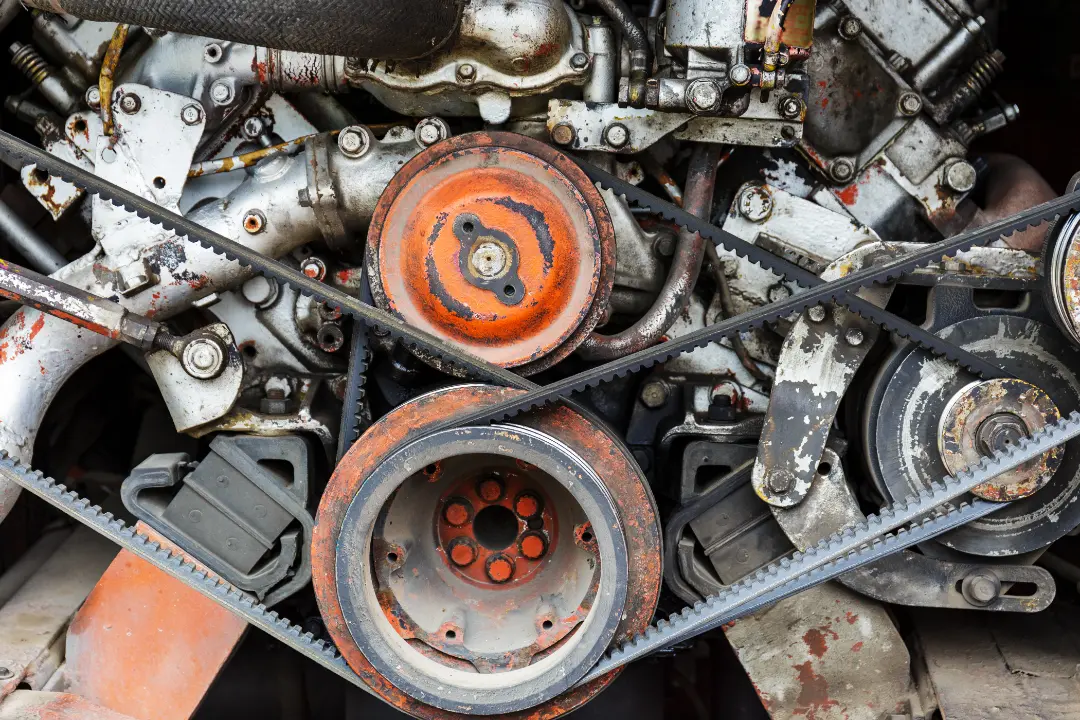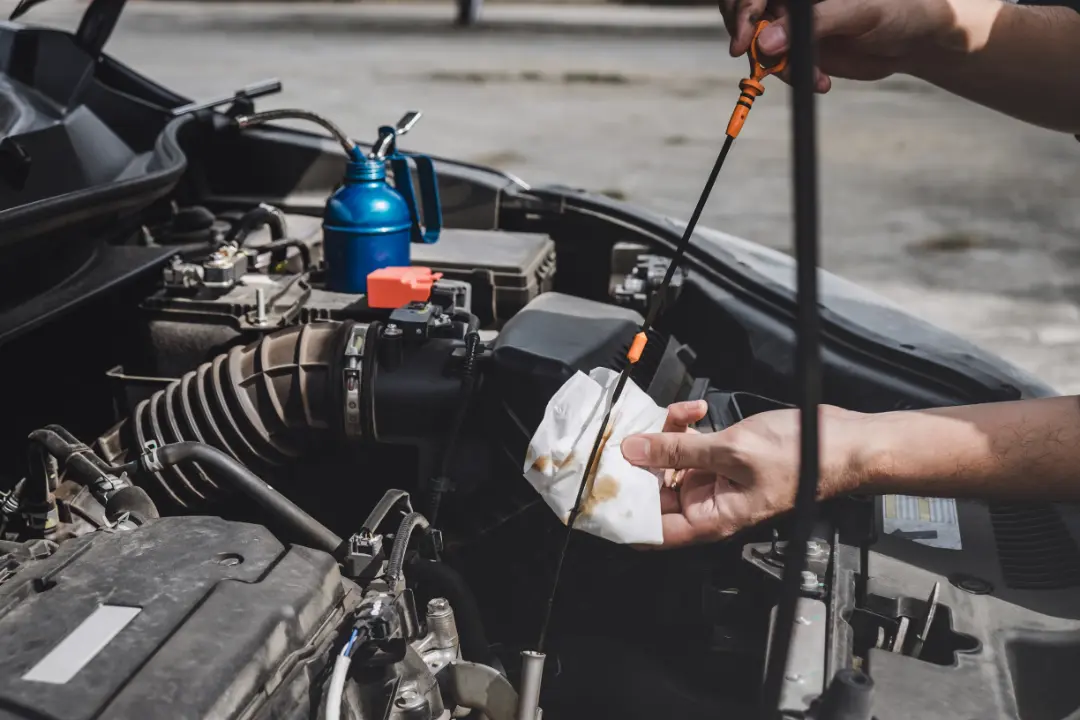Can you drive with a slow puncture? While it might seem manageable, driving with a slow puncture is not advisable. It can compromise vehicle control and increase the risk of accidents.
This article will explore what slow punctures are, their causes, risks, and the steps you should take if you suspect one.
Key Takeaways
- A slow puncture is a gradual air loss from a small hole in the tyre, often going unnoticed and leading to safety risks if not promptly addressed.
- Driving with a slow puncture can severely reduce vehicle control, increase stopping distances, and heighten the risk of tyre blowouts.
- Regular tyre maintenance, including pressure checks and visual inspections, is crucial for detecting slow punctures early and ensuring safe driving.
Understanding Slow Punctures
A slow puncture refers to when there is a small hole in the tyre. This hole results in a gradual loss of air. Slow punctures can sneak up on you, unlike larger, more noticeable punctures. They allow air to escape at a slow rate, often making their presence known only after considerable deflation has occurred.
One of the trickiest aspects of a slow puncture is its ability to go unnoticed for an extended period. A slow puncture can take days, or even up to a week, to deflate a tyre completely. This gradual drop in pressure can lead to continual air loss, requiring regular inflation just to maintain the correct pressure.
Even under normal conditions, tyres lose about 2 psi per month. However, a slow puncture accelerates this process, making monitoring your tyre pressure closely imperative. Regularly checking your tyres with a pressure gauge can help catch a slow puncture early, preventing unexpected flat tyres and the associated risks.

Causes of Slow Punctures
Understanding what causes slow punctures can help you prevent them. One of the most common causes is sharp objects on the road, such as nails or debris. These objects can create small holes in your punctured tyre, leading to gradual air loss over time.
Another frequent culprit is the tyre valve. If the valve is faulty, air can escape gradually. Corrosion or damage to the faulty valve stem can also result in slow air leakage, reducing tyre pressure and the potential for a full-blown tyre puncture if left unchecked.
The tyre size can play a role in how quickly a slow puncture develops. Larger tyres may lose air more slowly, but the gradual reduction in pressure can still result in dangerous handling issues over time.
Awareness of these causes allows for proactive measures like avoiding road debris and routinely checking tyre valves, minimising the risk of slow punctures.
How Tyre Size Affects Slow Punctures
The size of your tyre is an important factor to consider when assessing the potential risks of a slow puncture. Larger tyres, while often providing a smoother ride, can also lead to a slower leak that might be harder to notice until the tyre is considerably deflated. A small puncture in a larger tyre can result in a steady loss of air, affecting overall driving performance and tyre longevity.
Smaller tyres, on the other hand, may show signs of deflation more quickly but can also cause more noticeable handling issues.
It’s crucial to ensure that your tyre size matches your vehicle’s specifications to prevent irregular wear and help manage the impact of slow punctures. Regular checks on tyre pressure and tread wear can mitigate risks and ensure that your tyres are functioning at their best.
Signs of a Slow Puncture
Identifying signs of a slow puncture is vital for both safety and tyre longevity. One of the most obvious indicators is reduced tyre pressure. If you notice that one of your tyres consistently has lower pressure than the others, it might be causing air to escape gradually.
Another sign is uneven tyre wear. If one tyre wears down more quickly than the others, it could indicate a slow puncture. This uneven wear can also affect your vehicle’s handling, making it less stable and harder to control, especially during braking.
You might also notice your vehicle drifting or veering to one side while driving. This can be a clear sign that a tyre is losing air, affecting its performance and your control over the vehicle.
A slow puncture in the side wall is particularly dangerous, as this area bears the most weight and stress. Damage to the side wall can lead to an irreparable tyre, which is why it’s crucial to monitor its condition during regular inspections.
Regular visual checks of your tyres, as well as using a tyre pressure gauge, can help you identify a slow puncture before it worsens. These checks can reveal embedded objects or noticeable deflation, giving you a chance to address the issue promptly.
Risks of Driving with a Slow Puncture
Driving with a slow puncture is more dangerous than it might initially seem. One of the primary risks is decreased braking effectiveness. Low-pressure tyres can severely degrade your vehicle’s ability to stop quickly, which is especially hazardous in emergency situations.
If neglected, a slow puncture can escalate into more severe problems, such as a larger leak or a sudden tyre blowout. Blowouts often occur without warning, creating a substantial safety risk, particularly at high speeds.
Additionally, under-inflated tyres generate increased road friction, which not only accelerates tyre wear but also heightens the risk of a catastrophic failure. This risk becomes even greater when driving on highways, where high speeds exacerbate the dangers.
So, although you can technically drive with a slow puncture, it’s not recommended due to the steady loss of air pressure. Even with minor leaks, the effect on your tyre’s tread can cause it to wear unevenly, reducing traction and increasing the risk of a blowout.
To mitigate these risks, detecting and repairing slow punctures is crucial. Regular tyre inspections and immediate action when a slow puncture is suspected can ensure both your safety and the longevity of your tyres.
Can You Drive with a Slow Puncture?
While driving with a slow puncture is technically impossible, it is not advisable. A slow puncture compromises vehicle control, making steering unpredictable and increasing the risk of accidents. Reduced tyre pressure can also lead to longer stopping distances, posing a significant safety risk.
Continuing to drive on a slow puncture may cause permanent tyre damage and increase the risk of a blowout. This jeopardises your safety and leads to higher repair costs in the long run.
When driving with a slow puncture, vehicle stability, handling, and braking performance are all negatively affected. These compromised conditions can make everyday driving more dangerous, especially in adverse weather conditions or on uneven road surfaces.
If driving with a slow puncture is unavoidable, proceed with extreme caution and reduce speeds to maintain safety. However, the best course of action is to promptly address the issue to avoid these potential hazards.

Immediate Steps to Take
If you suspect a slow puncture, the first step is to check your tyre pressure using a pressure gauge. This will help you determine whether there is indeed a gradual loss of air and how severe it is.
The next step is to seek professional help as soon as possible. Whether you call a mobile mechanic or take your vehicle to a local garage, a professional assessment is crucial. They can accurately diagnose the issue and recommend the best course of action.
A prompt, professional assessment can prevent a slow puncture from escalating into a major safety risk. Addressing the issue promptly can prevent more significant problems down the road and ensure your vehicle remains safe to drive.
At All Vehicle Services (AVS) in Sittingbourne, we know how frustrating a slow puncture in your tyre can be, which is why we offer a mobile tyre fitting service designed for your convenience. Whether you’re at home, at work, or stuck on the roadside due to a slow puncture, our skilled technicians will come to you, saving you time and hassle. Available 24/7, our service ensures you get back on the road quickly and safely, no matter when you need help.
Repair Options
When it comes to repairing a slow puncture, several options are available. One temporary solution is using a repair kit, which can provide a short-term fix for small leaks until professional help is sought.
However, for a long-term and safe repair, seeking professional assistance is essential. A mechanic or tyre technician can thoroughly inspect and repair the puncture properly, ensuring that the tyre remains safe and functional.
In some cases, such as severe sidewall damage or significant corrosion, the tyre may need to be replaced rather than repaired. This is because certain types of damage are irreparable, regardless of the tyre’s type or quality.
Specific repair methods, such as using a rubber plug for punctures caused by debris like nails, can be effective for smaller holes. Punctures smaller than 1/4 inch (6mm) can potentially be repaired, but larger or more severe damages require professional evaluation and repair.
If the tread is worn down excessively, even a small puncture may not be reparable. In cases where the tread is significantly compromised, replacing the tyre may be the only safe option to avoid accidents.
Importance of Regular Tyre Maintenance
Regular tyre maintenance is key to preventing slow punctures and ensuring vehicle tyre safety. Regularly inspecting your tyre pressure and condition helps identify slow punctures and other potential issues early on.
Using a tyre pressure gauge and performing visual inspections can help detect gradual air pressure loss, which may indicate a slow puncture. Consistent need for inflation may suggest ongoing air loss and should be addressed promptly.
Proper tyre pressure improves grip and braking performance, which is essential for maintaining control while driving. By prioritising regular tyre maintenance, you can extend the lifespan of your tyres and ensure a safer driving experience.

All Vehicle Services: Comprehensive Tyre Solutions Tailored to Your Needs
At All Vehicle Services, we provide a wide range of tyres in Sittingbourne that are designed to meet every driver’s needs. Whether you’re dealing with a slow puncture or need a full tyre replacement, our extensive stock includes premium, mid-range, and budget-friendly options from top brands. No matter your preference or budget, we’ve got the perfect fit for your vehicle.
Our dedicated team of experts is always ready to assist you in ensuring you get the right tyre for your car and driving conditions. From summer tyres to winter tyres, we are here to keep your vehicle performing its best year-round.
Convenient Mobile Tyre Fitting Service
We know how inconvenient a slow puncture or flat tyre can be, which is why our mobile tyre fitting service is here to save the day. Available 24/7, including weekends and holidays, our skilled technicians will come to your location. You can rely on us to resolve your tyre issues promptly and professionally, wherever you are.
With All Vehicle Services, you won’t have to rearrange your day or wait in long queues at a garage. We bring our expertise to you, offering the convenience and efficiency you deserve to get back on the road quickly and safely.
We Offer Comprehensive Car Care
We offer a full suite of automotive services, from MOT checks and wheel alignments to full car servicing and air conditioning maintenance. We’re your one-stop solution for all your car care needs, ensuring every aspect of your vehicle gets the required attention.
Whether you’re a private car owner or managing a fleet, our experienced team delivers reliable, high-quality services tailored to your vehicle’s specific needs.
With over 10 years of serving Sittingbourne drivers, we’ve built a reputation for reliability, professionalism, and outstanding service. Our team of qualified technicians brings over 50 years of combined experience, ensuring every job is handled with precision and care.
Let us help you keep your car running smoothly and safely with our trusted expertise and dedication to customer satisfaction. Contact us today.
Frequently Asked Questions
What is a slow puncture?
A slow puncture is a small hole in a tyre that leads to a gradual loss of air pressure. It often goes undetected until the tyre becomes considerably deflated. It’s essential to monitor your tyre pressure regularly to avoid unexpected issues.
What causes slow punctures?
Slow punctures are typically caused by sharp objects like nails or debris penetrating the tyre, as well as problems with the valve due to corrosion or damage. Regularly inspecting your tyres can help identify when they start leaking air.
What are the risks of driving with a slow puncture?
Driving with a slow puncture poses serious risks, including decreased braking effectiveness, compromised steering wheel control, and the potential for tyre blowouts. These issues can make it challenging to maintain vehicle stability and put your safety at risk. Addressing tyre problems promptly ensures safe driving conditions and avoids unexpected accidents.
Can I drive with a slow puncture?
You should not drive with a slow puncture, as it compromises vehicle control and can lead to increased stopping distances and further tyre damage. The safest course of action is to address the issue promptly.
Conclusion
Understanding and addressing slow punctures is crucial for maintaining vehicle safety and performance. Recognising the signs, knowing the risks, and taking immediate steps can prevent more severe issues and ensure a safer driving experience.
Prioritise regular tyre maintenance and seek professional help when needed. This will prolong the life of your tyres, enhance your vehicle’s performance, and keep your journeys safe and smooth.


